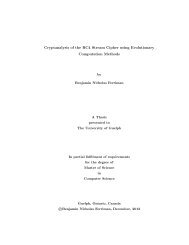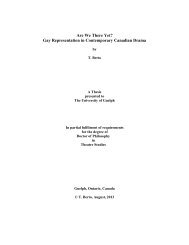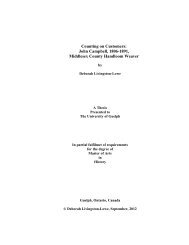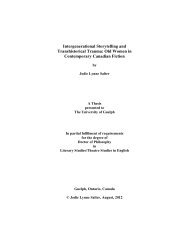THESIS - ROC CH ... - FINAL - resubmission.pdf - University of Guelph
THESIS - ROC CH ... - FINAL - resubmission.pdf - University of Guelph
THESIS - ROC CH ... - FINAL - resubmission.pdf - University of Guelph
You also want an ePaper? Increase the reach of your titles
YUMPU automatically turns print PDFs into web optimized ePapers that Google loves.
on the die to control cooling and depressurization so that film surface disruptions may be<br />
minimized.<br />
� Decrease water sensitivity: The main drawback for extruded SPI films is the water<br />
sensitivity which negatively affects both mechanical and barrier properties. Incorporation <strong>of</strong><br />
additives to reduce water sensitivity while maintaining the integrity for a sustainable solution<br />
should be explored. Proteins with increased hydrophobic groups such as zein, wheat<br />
gluten, etc. may decrease water sensitivity. Additional coatings could chemically bind to the<br />
surface <strong>of</strong> films to improve barrier properties.<br />
Part II: Cellulose Extraction from Soy Pods and Stems<br />
� Optimize the chemi-mechanical process: Each step in the applied chemi-mechanical<br />
process may be further optimized to achieve a higher degree <strong>of</strong> fiber quality. With smaller<br />
diameters and higher crystallinity, fiber properties should theoretically greatly improve.<br />
� Explore other fiber extraction methods: The pursuit <strong>of</strong> cellulose nan<strong>of</strong>ibers is still in its early<br />
phase where many research groups have shown multiple combinations <strong>of</strong> techniques which<br />
can obtain nan<strong>of</strong>ibers from a variety <strong>of</strong> sources. The use <strong>of</strong> enzymes has shown to be less<br />
harsh on the cellulose structure while effectively solubilizing other amorphous plant<br />
compounds. Future studies could employ other techniques besides the described chemi-<br />
mechanical process which may yield better results.<br />
Part III: Development <strong>of</strong> Soy-Fiber Composite Films<br />
� Explore methodological modifications: By solution casting SPI/fiber prior to extrusion, the<br />
addition <strong>of</strong> cellulose fibers may be increased without the complication <strong>of</strong> aggregate<br />
formation. With the aid <strong>of</strong> solution casting, fibers can be essentially coated with protein<br />
110

















